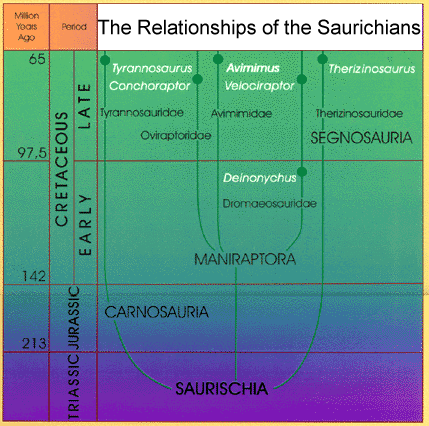
The
saurischian dinosaurs may be divided into several main groups:
the bipedal predators
Theropoda, aberrant herbivorous Segnosauria,
and herbivorous quadrupedal Sauropodomorpha.
Both
the theropods and sauropodomorphs existed from the Late Triassic until the end of
the Late Cretaceous and the segnosaurs are known only from the Late Cretaceous.
The
theropods greatly diversified in size, structure and style of life.
Two of their
groups, the carnosaurs and maniraptorans, are represented at the exhibition.
The
carnosaurian theropods include the largest terrestrial predators ever to have
inhabit
the Earth. They began to evolve as early as the Early Jurassic or even
Late Triassic
but they flourished in the Late Cretaceous.
In that time the largest carnosaurs
of the genus Tyrannosaurus
lived in both what is now
Central Asia and North America.
The Asian species, Tyrannosaurus
bataar
(which is frequently assigned to its own genus Tarbosaurus),
is
smaller than its North American relative Tyrannosaurus rex.
As
the former is some more ancient than the latter, it suggests the genus could initially
have
appeared in Asia and then entered North America through the wide land
bridge connecting
these continents in the Cretaceous.
The tyrannosaurs
possessed a huge head with very large cutting serrated teeth, stout and rather long
hindlimbs, and forelimbs greatly reduced as typical of all carnosaurs.
The brain
in this tremendous animal was unbelievably tiny in comparison with body size.
The
maniraptoran theropods are represented at the exhibit by dromaeosaurs,
oviraptorids, and avimimids.
These
dinosaurs have never reached such huge size, like the carnosaurs.
All maniraptorans
are distinguished from the latter by well-developed,
long and powerful forelimbs,
although they were definitely bipedal like the carnosaurs,
and did not use the
forelimbs for support when walking.
The dromaeosaurs were
medium-sized predators with an extremely large sickle-like talon on the inner toe.
The earliest dromaeosaur Deinonychus comes from the Early Cretaceous
of North America.
In the Late Cretaceous several genera of dromaeosaurs are known
from North America and Central Asia (Velociraptor).
The
oviraptors come exclusively from the Late Cretaceous of
Mongolia.
They differ from other maniraptorans by toothless jaws with frontal
parts probably covered by a horny bill. Such an unusual structure provoked a suggestion
that oviraptors ("egg burglars") might feed on
eggs of other reptiles, but it is more likely they fed on mollusks using powerful
toothless jaws to crash their shells.
A single known species of avimimids
come from the Late Cretaceous of Mongolia.
This very unusual dinosaur shares with
birds some characters in the
structure of the forelimb and shoulder girdle.
The
evolutionary history of sauropodomorphs was very successful and they had global
distribution
beginning from the Late Triassic untill the end of the Late Cretaceous.
Their
advanced members, the sauropods, embody the largest
terrestrial
tetrapods ever to have inhabited the Earth.
Some of them were more than 40 meters
long and up to 60-70 tons in weight.
Besides the skeletal remains the record of
this abundant and diverse group
of dinosaurs includes well-preserved egg clutches,
like one from the
Late Cretaceous of Mongolia displayed at the "Russian
Dinosaur Exposition".
The segnosaurs come only from
the Late Cretaceous of Mongolia and China
and are not well studied because of
the insufficient fossil record.
They were large or medium-sized bipedal planteaters
with relatively small head, massive body and stout hindlimbs. The relatively very
long and powerful forelimbs in segnosaurs possessed giant claws, that might be up
to 80 centimeters (2,6 feet) in length, like in Therizinosaurus
from Mongolia.




